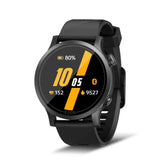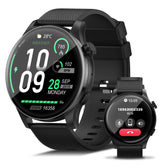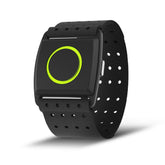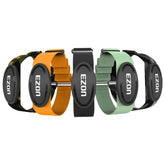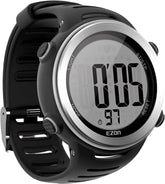カロリー燃焼101: 基礎から上級まで
運動中に体がどのようにカロリーを燃焼するかを理解することは、減量、筋肉増強、全体的な健康増進など、フィットネスの目標を達成したい人にとって非常に重要です。この包括的なガイドでは、カロリー消費に影響を与える要因や、カロリー消費を最大化する高度なテクニックなど、カロリー燃焼の基礎について説明します。さらに、 消費カロリー計算機、 カロリーカウンター付きスマートウォッチ、 最高のスマートフィットネストラッカーなどのテクノロジーが、カロリー消費の理解と管理をどのように強化できるかについても説明します。
カロリー燃焼の基本
カロリーとは何ですか?
カロリーはエネルギーの単位です。食べ物を摂取するとカロリーを摂取し、身体活動をすると体はそのカロリーをエネルギーとして使います。摂取カロリーと燃焼カロリーのバランスによって、体重が増えるか、減るか、あるいは維持されるかが決まります。
どれくらいのカロリーを消費しますか?
カロリー消費は、次のようないくつかの要因によって影響を受けます。
-
基礎代謝率 (BMR) : これは、呼吸や循環など、安静時に基本的な生理機能を実行するために体が必要とするカロリー数です。BMR は通常、1 日のカロリー消費量の約 60 ~ 75% を占めます。
-
身体活動: 運動や日常の動作によって消費されるカロリー。これには、計画的なトレーニングから、ウォーキングや階段の昇降などの日常的な活動まですべてが含まれます。
-
食物の熱効果 (TEF) : 食物を消化、吸収、代謝するために使用されるエネルギー。これは、1 日の消費カロリーの約 10% を占めます。
カロリー消費に影響を与える要因
-
体組成: 筋肉組織は脂肪組織に比べて安静時に多くのカロリーを燃焼します。そのため、筋肉量が多い人は通常、BMR が高く、全体的に多くのカロリーを燃焼します。
-
運動時間: 運動時間が長くなるほど、一般的に消費カロリーも増えます。たとえば、同じ強度であれば、60 分間のランニングは 30 分間のジョギングよりも多くのカロリーを消費します。
-
活動の種類: 運動の種類によって、消費カロリーの速度は異なります。例:
- 通常、有酸素運動(ランニング、サイクリング、水泳)は、同じ時間行うと無酸素運動(ウェイトリフティング)よりも多くのカロリーを消費します。
-
運動の強度: 強度の高い運動は、より短い時間でより多くのカロリーを燃焼します。たとえば、高強度インターバルトレーニング (HIIT) は、中程度の強度の定常有酸素運動よりもカロリー燃焼に効果的です。
テクノロジーを活用してカロリー消費を追跡する
1. 消費カロリー計算機
消費カロリー計算機は、体重、運動時間、運動強度レベルに基づいて、さまざまな活動中に消費するカロリー数を推定するのに役立ちます。このツールは、現実的なフィットネス目標を設定し、進捗状況を追跡するのに役立ちます。
2. カロリーカウンター付きスマートウォッチ
カロリーカウンター付きのスマートウォッチは、運動中のカロリー消費に関するリアルタイムのデータを提供します。これらのデバイスには、心拍数モニタリング、アクティビティ追跡、さらには屋外アクティビティ用の GPS 機能などの機能が搭載されていることが多く、フィットネスの進捗状況を総合的に把握できます。
3. カロリーカウンターウォッチ
カロリーカウンターウォッチは、運動中に消費されたカロリーを追跡するだけでなく、毎日の活動レベルも監視できます。多くのモデルは、安静時の代謝率と 1 日の総エネルギー消費量に関する情報を提供し、カロリー管理のより完全なイメージを提供します。
4. 最高のスマートフィットネストラッカー
最高のスマート フィットネス トラッカーに投資することで、カロリー燃焼を監視および最適化する能力を高めることができます。次のような機能に注目してください。
- 正確な心拍数モニタリング
- アクティビティの追跡(歩数、距離、活動時間)
- カロリー摂取量を追跡するための栄養アプリとの統合
- 長時間のバッテリー寿命で継続的なモニタリングが可能
カロリー消費を最大化する高度なテクニック
-
高強度インターバルトレーニング (HIIT) を取り入れる: このトレーニング方法では、短時間の高強度運動と休憩または低強度の期間を交互に繰り返し、トレーニング中およびトレーニング後のカロリー消費量を増加させます。
-
筋力トレーニングを追加する: 筋力トレーニングを通じて筋肉を鍛えると、安静時の代謝率が上がり、体が安静時でもより多くのカロリーを燃焼できるようになります。
-
トレーニング時間と頻度を増やす: トレーニング時間を徐々に延長し、セッションの頻度を増やすと、時間の経過とともに総消費カロリーが増加する可能性があります。
-
複合運動を活用する: 複数の筋肉群を同時に鍛える運動 (スクワット、デッドリフト、腕立て伏せなど) は、単独の運動に比べて消費カロリーを増やすことができます。
-
一日中活動的に過ごす: 階段を使う、休憩中に歩く、仕事中に立つなど、日常生活にもっと運動を取り入れましょう。こうした小さな変化が積み重なって、かなりのカロリー消費につながります。
結論
カロリー燃焼の基礎を理解することは、フィットネスと健康を改善したい人にとって不可欠です。カロリー消費に影響を与える要因を認識し、消費カロリー計算機、カロリーカウンター付きスマートウォッチ、最高のスマートフィットネストラッカーなどのテクノロジーを活用することで、体のエネルギーニーズに関する貴重な洞察を得ることができます。高度なテクニックを実装すると、カロリー燃焼をさらに高めることができ、フィットネス目標をより効果的に達成するのに役立ちます。旅を受け入れ、情報を入手し、より健康的なライフスタイルのためにカロリー管理をコントロールしてください。
